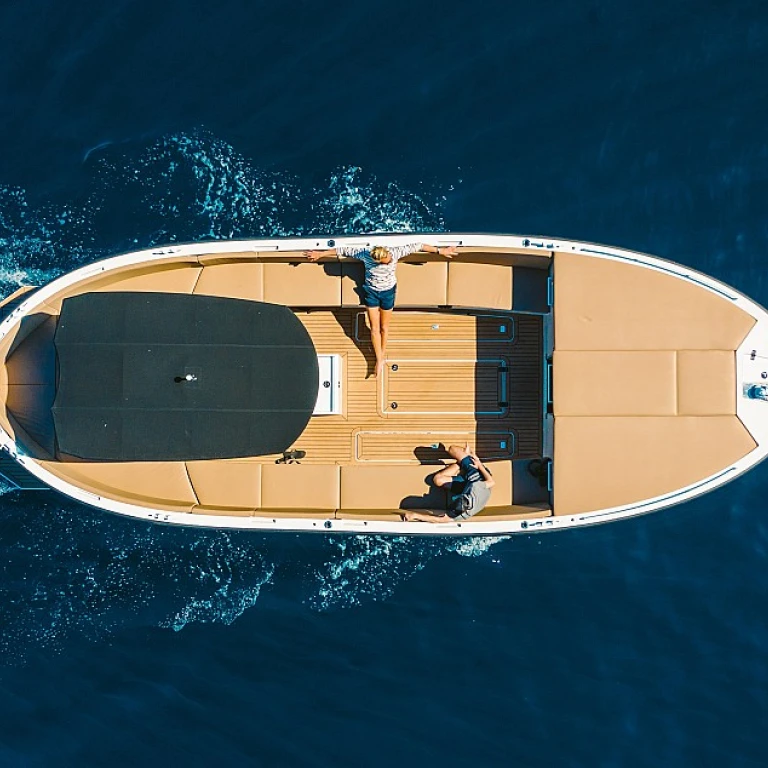-large-teaser.webp)
The Anatomy of a Yacht Deck
An Overview of Yacht Deck Anatomy
Understanding the anatomy of a yacht deck is crucial for anyone passionate about the yacht industry. A yacht deck encompasses several key components, each with specific roles in ensuring the safety and functionality of the vessel. Yacht decks are designed to endure harsh marine environments while providing comfort and aesthetics. A well-constructed deck structure includes several essential components such as the joists, beams, and support posts, which form the deck's main skeleton. The joists serve as the primary horizontal supports upon which deck boards are laid to create the surface, while beams provide additional reinforcement to distribute weight and ensure structural integrity. The support posts anchor the deck securely, connecting it to the yacht's main body. The surface of the deck comprises various materials, with composite decking and wood being popular options. These materials provide durability and an aesthetic appeal necessary for resisting weather and wear over time. Decking boards form the visible part of the deck, where yacht owners and guests spend much of their time enjoying the sea views. In addition to the foundational parts, the deck also includes a railing system, which is critical for safety. Railing posts, top rail, and deck railing ensure that passengers can move about the deck without the risk of falling overboard. Another crucial component is flashing, which is used to prevent water infiltration at joints and seams, while ledger boards connect the decks to the main structure of the yacht. Furthermore, different deck designs cater to various aesthetic preferences and functional needs, allowing for a personalized touch to every yacht. As you explore the anatomy of yacht decks, you'll also want to understand the role of helm pump drive hydraulic cylinders in enhancing maneuverability, as these systems are often integrated to ensure smooth handling. The complexity of a yacht's deck system requires careful planning and execution, often tailored to meet local building standards and environmental considerations. As we delve into further sections, detailing key parts and design innovations, it becomes evident that a yacht deck is much more than just a platform; it's a fundamental aspect contributing to the overall yachting experience.Key Deck Parts and Their Functions
Exploring the Essential Elements of a Yacht Deck
When it comes to understanding the anatomy of a yacht deck, recognizing the key parts and their functions is crucial. Each component plays a vital role in ensuring the deck's integrity, safety, and usability. Let's delve into the essential elements that make up a yacht deck.
Structural Components
- Joists and Beams: These are the backbone of the deck structure, providing the necessary support and stability. Joists run parallel to each other, while beams are typically perpendicular, ensuring the deck can withstand various loads.
- Support Posts and Footings: These parts are critical for maintaining the deck's elevation and stability. Support posts connect the deck to the footings, which are anchored into the yacht's hull, providing a solid foundation.
- Ledger Board: This component attaches the deck to the yacht's main structure, distributing weight and ensuring the deck remains securely in place.
Surface and Safety Features
- Decking Boards: The surface of the deck is made up of these boards, which can be crafted from various materials, including wood and composite decking. They provide a durable and aesthetically pleasing surface for walking and lounging.
- Railing System: Safety is paramount on a yacht deck, and the railing system, including top rails and railing posts, ensures passengers are protected from falling overboard.
- Flashing: This part is essential for preventing water intrusion, protecting the deck structure from moisture damage.
Understanding these components is vital for anyone involved in yacht deck building or maintenance. Each part, from the joists to the deck surface, plays a role in creating a safe and enjoyable environment on board. For those looking to enhance their yacht experience, consider enhancing your yacht experience with a pet-friendly boat ramp, which can be a valuable addition to your deck's functionality.
Materials Used in Deck Construction
Materials That Define the Sturdiness and Style
The construction of a yacht deck is an intricate process that involves several vital materials, each serving a specific purpose to ensure the deck's functionality, longevity, and aesthetics. Selecting the right materials is crucial as it directly impacts the yacht's overall durability and performance.- Wood and Composite Decking: Traditionally, wood has been the favored material for decking due to its natural beauty and timeless appeal. However, in recent years, composite decking has gained popularity, offering a balance between aesthetics and low maintenance. Composite materials are often preferred for their resistance to weather conditions and reduced long-term upkeep.
- Joists and Beams: Structural integrity in yacht decks largely depends on the robust support provided by joists and beams. These components are meticulously engineered and constructed to withstand marine environments while holding up the decking boards securely.
- Railing Systems: Safety and styling go hand-in-hand with the choice of railings. Depending on the yacht design, the railing system can be made from various materials such as stainless steel, glass panels, or strong composite options to ensure both functionality and elegance.
- Ledger and Flashing: Essential to the deck structure, the ledger board is one of the critical parts deck builders must integrate carefully. Paired with reliable flashing, it prevents water infiltration, protecting the yacht structure from moisture-related damages.
- Deck Boards: Available in different materials and finishes, the decking boards are selected to enhance both the aesthetic appeal and safety of the deck surface. From anti-slip finishes to UV-resistant coatings, these boards are crucial for both visual appeal and performance.
Innovative Deck Designs in Modern Yachts
Exploring Cutting-Edge Deck Structures in Contemporary Yachting
In the exciting world of yacht design, the deck remains a focal point for innovation and technological advancement. This part of the yacht serves as a hub for social activities, necessitating both form and function. To achieve this, modern yacht manufacturers are pushing the envelope with creative deck structures and materials. One of the notable advancements is the use of composite materials in deck construction. Composite decking, made by blending natural wood fibers with synthetic materials, offers a surface that is both beautiful and highly durable. It requires less maintenance compared to traditional wood, which is a significant advantage in the demanding marine environment. Decking boards made from composite materials are designed to withstand the corrosive effects of saltwater, providing longevity. The structural backbone of a yacht deck also sees innovations with the use of engineered joists and beams. These components are critical as they provide essential support, maintaining the integrity and stability of the deck surface. The joists and parts are carefully selected to balance weight without compromising strength, which is crucial for smooth sailing. Innovative railing systems play a vital role in modern yacht decks, combining safety with sleek aesthetics. Railing posts and top rails are now designed with versatile materials and styles to enhance the seamless appearance of a yacht while ensuring passenger security. Flashing and ledger boards are crucial elements integrated into the deck layout to prevent water infiltration, which is pivotal in prolonging the life of the decking structure. The precise installation of these components underscores the importance of a meticulous deck building process, addressing potential challenges mentioned earlier. Innovations in local building techniques also contribute to the modern yacht deck's evolution. Techniques that incorporate advanced support posts and footings ensure stability and enhance the yacht’s ability to weather various nautical environments. Overall, these modern designs and materials position the yacht deck not only as a functional space but also as a testament to cutting-edge advancements in yacht building.Maintenance Tips for Yacht Decks
Regular Care for Your Yacht Deck
Maintaining the beauty and functionality of your yacht deck requires consistent effort. Routine maintenance is essential to preserve the deck's components like joists, ledger boards, and decking boards. Here are some practical tips to keep your deck in top condition:- Inspect Regularly: Pay special attention to the deck structure including beams, flashing, and support posts. Look for signs of wear, damage, or corrosion in the railing system and footings, as these could compromise the deck's integrity.
- Cleaning: Regular cleaning of the deck surface prevents grime build-up that can cause deterioration. Use suitable detergents and a soft brush for wood decks, while a gentle wash with water is ideal for composite decks to avoid scratching.
- Protective Treatments: Wood decks particularly benefit from sealing or staining to protect against moisture and UV exposure. This helps maintain the deck parts, ensuring longevity and resilience against harsh marine conditions.
- Tightening and Securing: Regularly check the joists, railing, and top rail systems for loose fittings or parts. Ensuring these are secure will prevent wobbling and potential accidents when the yacht is underway or when docked.
- Professional Inspection: Annually, consider hiring a professional for a thorough inspection of your deck building, checking for underlying issues that might not be visible at first glance. This is particularly recommended for complex or modern decks with intricate designs.
Challenges in Yacht Deck Design
Overcoming Common Hurdles in Crafting a Yacht Deck
Designing and building a yacht deck is a complex process that involves addressing multiple challenges, each crucial to the overall integrity and functionality of the deck structure. Understanding the anatomy of a yacht deck is integral to navigating these obstacles effectively.- Structural Support and Stability: Ensuring the deck's stability is paramount. This involves a precise arrangement of joists, beams, and ledger boards, which work together to provide a solid frame. Proper support posts and footings must be in place to resist the unique stresses experienced at sea.
- Material Selection: The choice between wood and composite decking can significantly impact maintenance requirements and longevity. Composite deck materials, for instance, offer greater resistance to the elements and require less upkeep. However, they may necessitate specific fittings for their fastening and support.
- Weather Resistance and Water Drainage: A yacht deck must withstand constant exposure to water and varying weather conditions. An effective drainage system, incorporating flashing and drainage rails, prevents water pooling and subsequent damage to deck boards and other parts.
- Safety and Comfort: Ensuring user safety is also crucial. Deck railings, top rails, and railing posts must be robust to prevent accidents, providing a balance between durability and aesthetic appeal. The surface of the deck must be non-slip and comfortable underfoot to enhance passenger experience.
- Complex Designs and Innovations: As innovations in deck design continue to evolve, integrating new features while maintaining structural integrity can be challenging. This requires a detailed understanding of the individual components like deck parts and their functions, allowing for seamless integration of modern amenities.













